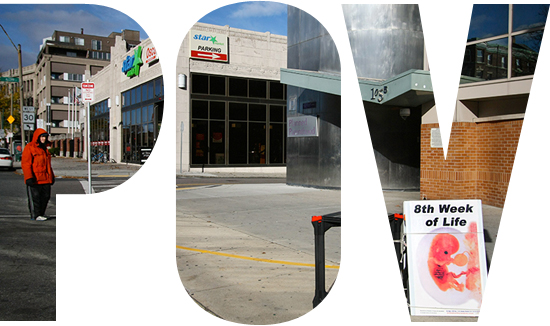POV: Why Supreme Court’s “Buffer Zone” Decision Is Wrong
LAW prof says decision underscores difficulty of balancing fundamental rights

Photo by Emily Zaboski/Daily Free Press
Not often does the US Supreme Court focus in your backyard, but that happened last Friday when it struck down the Massachusetts law creating “buffer zones” around reproductive health facilities. This legal battle started as a weekly street brawl between anti-abortion protestors and employees and patients at the Planned Parenthood health center on the western edge of the BU campus. McCullen v. Coakley gives a victory, albeit a limited one, to the anti-abortion protestors who have fought against buffer zones since they were first created 14 years ago. This law—and the Court’s decision—is not about abortion, but how difficult balancing fundamental rights is for legislatures and courts.
Protests at reproductive health centers have been a reality since Roe v. Wade. Although McCullen focuses on the activities of “sidewalk counselors” who claim they engage patients in “quiet and gentle” conversations, there are other protestors who seek to block clinic doors and driveways, to harass patients and employees, and to disrupt the clinic’s work with noise and commotion. Some resort to murder; in 1994 John Salvi attacked two Boston area clinics, killing two young women and injuring several others.
A buffer zone is meant to push the abortion debate away from the entrances to clinics. These zones are possible because the First Amendment is not absolute—the government can restrict speech through reasonable time, place, and manner regulations. So long as the law does not assist one side of an argument (is “content-neutral”), the government does not have to find the least restrictive regulations possible, but it still may not burden more speech than is necessary to further the government’s goals. In this case, the government has several legitimate goals: ensuring public safety, promoting the free flow of traffic on streets and sidewalks, and protecting a women’s right to seek reproductive health care. How narrow the restrictions must be is the tricky part.
Massachusetts legislators took this balancing between speech and public safety very seriously. In fact, many of the Legislature’s strongest reproductive rights supporters are also the staunchest defenders of free speech. In 2000, the Senate passed a 25-foot fixed zone around clinic doors that protestors could not enter, legislation the state Supreme Judicial Court found constitutional. In an attempt to burden less speech, the Legislature ultimately settled on a buffer zone where “counselors” could come within six feet of a patient if the patient gave permission. This compromise was modeled on a Colorado law the US Supreme Court had recently found constitutional. This law, however, was nearly impossible to enforce; patients still felt harassed, and protestors rarely knew when or if they were breaking the law. In 2007, when Attorney General Coakley and police officials asked for changes, lawmakers created a 35-foot bright-line—literally painted on the sidewalk—that protestors could not cross.
Did the Supreme Court make the right decision in striking down this buffer zone? In my opinion, no. The original law attempted to restrict as little speech as possible, and it did not work. The Legislature made another good faith effort to create a narrow solution that met a persistent public safety problem. The court claimed there were alternative methods for preventing clinic obstruction and obvious harassment, which Chief Justice Roberts claimed was “anything but subtle” in the case of abortion. That is not true—harassment can be quite subtle when leaflets and “quiet counseling” include the words “sinner,” “baby-killer,” and “Hell.” Women should be able to meet with a doctor without being shadowed by either “counselors” or “escorts” and having the emotional abortion debate rage around them as they make their way to the door. The police should not be left to guess who has violated a six-foot “bubble,” who is being harassed, and who is being “counseled.” The court should have given Massachusetts lawmakers more deference, given that they had first tried a less restrictive approach and it was ineffective.
This decision is not the complete victory anti-abortion protestors sought. By finding the statute content-neutral, the court leaves open the possibility for the Legislature to craft a new buffer zone—which is likely before the end of the summer. Once again, lawmakers will balance important rights and hope they have found the right solution for when the law is again challenged and the court again passes judgment.
Sean J. Kealy is a clinical associate professor of law and the director of legislative clinics at the School of Law. He previously served as legal counsel to the Massachusetts Legislature’s Criminal Justice Committee, which created the original Buffer Zone Law in 2000. He can be reached at skealy@bu.edu.
“POV” is an opinion page that provides timely commentaries from students, faculty, and staff on a variety of issues: on-campus, local, state, national, or international. Anyone interested in submitting a piece, which should be about 700 words long, should contact Rich Barlow at barlowr@bu.edu. BU Today reserves the right to reject or edit submissions. The views expressed are solely those of the author and are not intended to represent the views of Boston University.
Comments & Discussion
Boston University moderates comments to facilitate an informed, substantive, civil conversation. Abusive, profane, self-promotional, misleading, incoherent or off-topic comments will be rejected. Moderators are staffed during regular business hours (EST) and can only accept comments written in English. Statistics or facts must include a citation or a link to the citation.